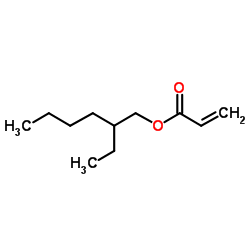2-Ethylhexyl acrylate

2-Ethylhexyl acrylate structure
|
Common Name | 2-Ethylhexyl acrylate | ||
|---|---|---|---|---|
| CAS Number | 103-11-7 | Molecular Weight | 184.275 | |
| Density | 0.9±0.1 g/cm3 | Boiling Point | 216.0±0.0 °C at 760 mmHg | |
| Molecular Formula | C11H20O2 | Melting Point | -90ºC | |
| MSDS | Chinese USA | Flash Point | 79.4±0.0 °C | |
| Symbol |

GHS07 |
Signal Word | Warning | |
|
Development and application of a non-targeted extraction method for the analysis of migrating compounds from plastic baby bottles by GC-MS.
Food Addit. Contam. Part A. Chem. Anal. Control. Expo. Risk Assess. 31(12) , 2090-102, (2014) In 2011, the European Union prohibited the production of polycarbonate (PC) baby bottles due to the toxic effects of the PC monomer bisphenol-A. Therefore, baby bottles made of alternative materials, e.g. polypropylene (PP) or polyethersulphone (PES), are cur... |
|
|
Prediction of the reduced glutathione (GSH) reactivity of dental methacrylate monomers using NMR spectra - Relationship between toxicity and GSH reactivity.
Dent. Mater. J. 28(6) , 722-9, (2009) It has been established that the toxicity of acrylate and methacrylate monomers is driven by their reactivity towards glutathione (GSH). With this relationship, the objective of this study was to predict the GSH reactivity of dental methacrylate monomers, and... |
|
|
The potential dermal irritating effect of residual (meth)acrylic monomers in pressure sensitive adhesive tapes.
Drug Chem. Toxicol. 33(1) , 1-7, (2010) It is generally thought that residual unpolymerized (meth)acrylic monomers commonly found in pressure sensitive adhesive tapes for medical use may cause dermal irritation, but a systematic study has never been carried out. Therefore, we assessed the potential... |
|
|
Plasma-induced polymerization for enhancing paper hydrophobicity.
Carbohydr. Polym. 92(1) , 928-33, (2013) Hydrophobic modification of cellulose fibers was conducted via plasma-induced polymerization in an attempt to graft the hydrophobic polymer chains on paper surface, this increasing the hydrophobicity of paper. Two hydrophobic monomers, butyl acrylate (BA) and... |
|
|
Dermal oncogenicity study of 2-ethylhexyl acrylate by epicutaneous application in male C3H/HeJ mice.
J. Cancer Res. Clin. Oncol. 115(6) , 543-9, (1989) A carcinogenicity bioassay of 2-ethylhexyl acrylate (2-EHA) was conducted by applying 25 microliters 86.5%, 21%, or 2.5% 2-EHA in acetone three times a week to the clipped dorsal skin of male C3H/HeJ mice (80 per group) over their lifetime. Another group was ... |
|
|
Allergic contact dermatitis from 2-ethylhexyl acrylate contained in a wig-fixing adhesive tape and its 'incidental' therapeutic effect on alopecia areata.
Contact Dermatitis 58(3) , 170-1, (2008)
|
|
|
[Substantiation of maximum permissible level of 2-ethylhexyl acrylate in atmospheric air].
Gig. Sanit. (12) , 19-21, (1991)
|
|
|
Impregnation of an intraocular lens for ophthalmic drug delivery.
Curr. Drug Deliv. 5(2) , 102-7, (2008) In this work the possibility of impregnating P(MMA-EHA-EGDMA) with flurbiprofen using a clean and environmentally friendly technology, namely supercritical fluid technology was evaluated. P(MMA-EHA-EGDMA) has been proposed as a promising matrix to be used for... |
|
|
Evaluation of poly(acrylic acid-co-ethylhexyl acrylate) films for mucoadhesive transbuccal drug delivery: factors affecting the force of mucoadhesion.
J. Control. Release 67(2-3) , 223-32, (2000) Based on the premise that similar surface properties between the adhesive and the substrate would yield a strong adhesive bond, copolymers of acrylic acid (AA) and 2-ethylhexyl acrylate (EHA), P(AA-co-EHA), were designed and synthesized for buccal mucoadhesio... |
|
|
The sensitizing potential of 2-ethylhexyl acrylate in the guinea pig.
Contact Dermatitis 9(5) , 372-6, (1983) The sensitizing potential of 2-ethylhexyl acrylate in the guinea pig could be demonstrated by Freund's Complete Adjuvant Test. This acrylate ester is a common constituent of adhesive tape. Allergic reactions to several brands of adhesive tape were not observe... |